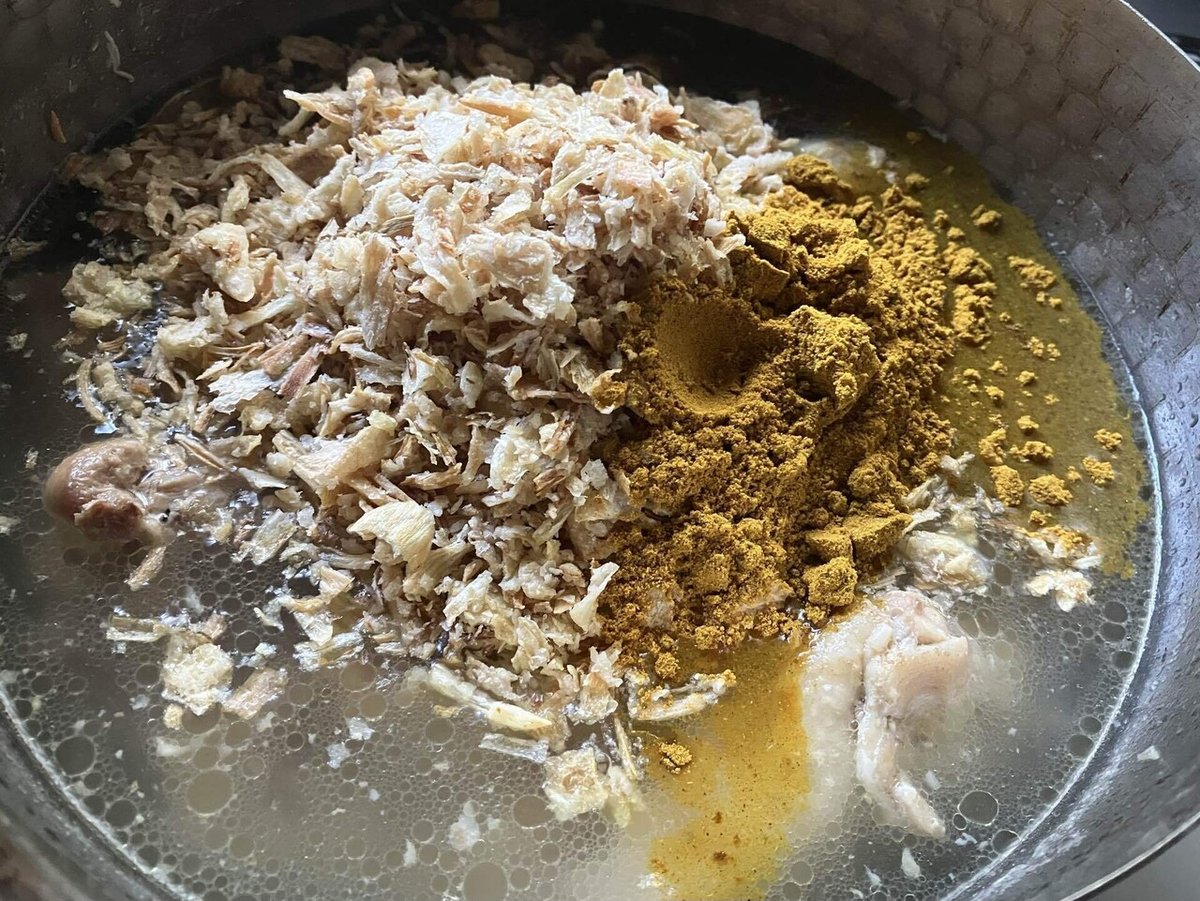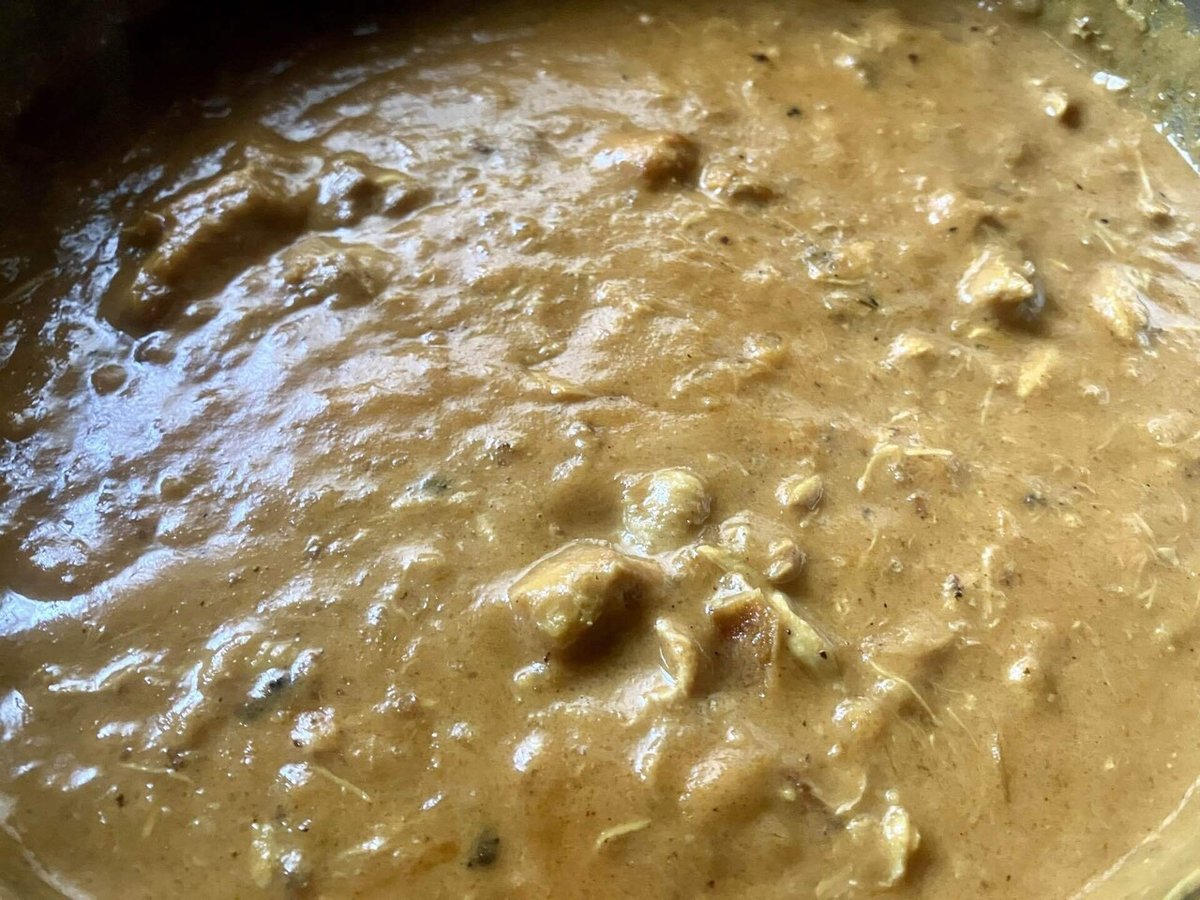
CoCo壱的展開のための基本のチキンカレー Basic chicken curry for menu development like CoCo Ichibanya
ハーブとスパイスの誘惑 The temptation of herbs and spices
ストーリー
Recipe trivia
これは、CoCo壱のようなカレーメニューの展開のために作ったカレーの基本レシピ。CoCo壱のカレーは日本で独自に発展したカレーライス文化を踏襲している。すなわち、欧風カレーのソースを日本米と合わせ、辛さと様々なトッピングが選べる日本化したカレーだ。中国の麺料理から日本化したラーメンと同様、本場のカレー(多様な食文化を誇るインドや東南アジアのスパイス料理をカレーという言葉で括ってしまうのはあまりにも乱暴ではあるけど)とは別の料理と言えるかもしれない。最近ではラーメンの中国への逆輸出と同様、インドでも展開が始まっている。
チェーン店でよく使われる安く手に入るカレーフレークを使うのも手だけれど、個人店向けに、無添加で味にこだわりを持てるような自家製のカレーソースとして仕上げた。CoCo壱はポークやビーフのカレーを基本にしているけど(インド進出のバージョンは宗教的な配慮をしている)、ハラルやグルテンフリーなど、幅広いニーズに応えられるよう、鶏肉を使って小麦粉を使わないレシピとした。小さな厨房で短時間に仕込めるよう、あえてスパイス調合は避け、市販のカレー粉を使った。追加スパイスやトッピング、付け合わせを工夫すれば、店独自の展開に繋がるシンプルな味付けにしている。
ベジタリアン版のレシピもあるが、そちらはまた別の記事で紹介したい。
This is the basic recipe for curry made for the development of curry menus like CoCo Ichibanya. CoCo Ichibanya's curry follows the curry rice culture that developed uniquely in Japan. In other words, it is a Japanese version of curry that combines European-style curry sauce with Japanese rice and allows you to choose the spiciness and various toppings. Like ramen, which was made Japanese from a Chinese noodle dish, it may be said to be a different dish from real curry (although it is too rough to generalize the spice dishes of India and Southeast Asia, which boast diverse food cultures, under the term curry). Recently, it has started to be developed in India as well, just like ramen has been exported back to China.
It is also possible to use cheap curry flakes that are often used in chain restaurants, but for individual restaurants, it is a homemade curry sauce that is additive-free and allows you to be particular about the taste. CoCo Ichibanya is based on pork and beef curry (the version in India takes religious considerations into account), but in order to meet a wide range of needs such as halal and gluten-free, the recipe uses chicken and does not use wheat flour. In order to be able to prepare it in a short time in a small kitchen, we deliberately avoided mixing spices and used commercially available curry powder. The seasoning is simple and can be customized to suit your own unique taste by adding additional spices, toppings, and garnishes.
There is also a vegetarian recipe, which I will introduce in another article.
Ingredients:
材料:
鶏手羽元※1
揚げ玉葱※2
トマトペースト
生姜
カレー粉(お好みの銘柄)
自然塩
黒糖
※1 鶏の安い他の部位、鶏ガラでも良い。
※2 時短のため。玉葱を自分で炒めても良い。
Chicken wings*1
Fried onions*2
Ginger
Curry powder (your favorite brand)
Tomato paste
Natural salt
Brown sugar
*1 You can also use other cheaper chicken parts or chicken bones.
*2 To save time. You can also fry the onions yourself.
procedure:
手順:
手羽元肉とスライスした生姜を鍋に入れ、水を注いで40分以上煮込み、鶏の出汁を取る。鶏肉はほぐしてトッピングに使ったり、コロッケなどに練り込んでも良い。
鶏の出汁に揚げ玉葱とカレー粉の70パーセント、トマトペーストを入れ、弱目の中火で30分ほど煮込む。
鶏肉ごと煮溶かしてしまうなら、あるいは試作などで鶏肉ごと食べてしまうのなら、肉は取り除かなくても良く、最初からカレー粉や玉葱も入れてしまい、つまりここまでの二つの工程を一緒にしてしまい、40分ほど煮込めば良い。
残りの30パーセントのカレー粉を足し、塩を入れて基本の味付けをし、味を見ながら黒糖を入れて好みの味に仕上げる。後で、辛みスパイスを加えたり、生クリームやパターなどで仕上げることを考えれば、少し控えめな味付けにする方が応用範囲が広い。カレー粉もそのことを念頭に量を決めると良い。
業務に使うなら、この時点で鍋ごと氷水に浸けるか、丈夫な袋に入れて氷水で10度以下に急冷する。この工程を入れることで、保存期間が飛躍的に延びる。
Put chicken wings and sliced ginger in a pot, pour in water and simmer for at least 40 minutes to make chicken stock. You can shred the chicken and use it as a topping or mix it into croquettes.
Add fried onions, 70 percent of the curry powder, and tomato paste to the chicken stock and simmer over low to medium heat for about 30 minutes.
If you are going to cook the chicken until it melts, or if you are making a prototype and will eat the whole chicken, you don't need to remove the meat, just add the curry powder and onions from the beginning, which means you can combine the two steps up to this point and simmer for about 40 minutes.
Add the remaining 30% of the curry powder, add salt to give it a basic flavor, and add brown sugar while tasting to finish it to your liking. If you plan to add spicy spices or finish it with cream or butter later, it is better to use a slightly more modest seasoning for a wider range of applications. It is a good idea to decide the amount of curry powder with this in mind.
If you are using it for commercial purposes, at this point, you should either immerse the whole pot in ice water or place it in a sturdy bag and quickly cool it to below 10 degrees. This step will dramatically extend the shelf life.






Tips and tricks:
コツと応用のヒント:
鶏出汁を取るのに、ここでは手に入りやすく安価な手羽元のみを使っているが、手羽先肉や鶏ガラ、鶏の他の部位を使っても良い。また、無添加だとコストは嵩むが市販の鶏ガラスープを使っても良い。鶏ガラを使う場合は、一旦湯がいてからよく洗ってから使うと、臭みがでない。このスープは応用範囲が広いので、他の料理への展開も考えて取る量やタイミングを決めると良い。カレーのみに使い、肉も煮溶かしてしまうなら、前工程で出汁を取る必要はなく、肉も一緒に煮込んでしまえば良い。鶏肉は大体40分程度煮込むと骨から外れるくらい柔らかくなるので、煮崩れる前に丁寧に取り出して、後でトッピングに使う手もある。この辺りの工程は、それぞれの店の都合でアレンジすれば良いと思う。
このレシピでは、とろみをつけるのに玉葱のみを使っている。日本のカレーソースは小麦粉を炒めてとろみを出す場合が多いけれど、グルテンフリー対応を前提とし、炒めるというフライパンに付きっきりで、かつ炒めムラが出ない熟練が必要な、小麦粉炒めの工程を省略するために、玉葱のみを使っている。また、玉葱は自然の甘みがあり、そのフレーバーは味に奥行きをもたらしてくれるので、小麦粉を大量に使う場合に比べて、後で余分な添加物を必要としないため、多めに使っている。
玉葱を炒める工程は面倒なので、忙しい店の時短のためにここではあえて揚げ玉葱を使っている。炒め玉葱も素材として市販されているけど、割高なのと常温保存ができないので、使い勝手の良い揚げ玉葱を使っている。中華材料の揚げ赤ネギも同様に使え、安く手に入る。
自分で玉葱を炒めたい人は、次の工程を挟んで貰えば良い。
無水鍋など、蒸気の逃げにくい構造の鍋を使い、多めに油(酸化しやすい油は避けよう)を敷いて、繊維に垂直にスライスした大量の玉葱を入れ、ざっと掻き回して油を玉葱に纏わせ、蓋をして中火の弱火で加熱する。鍋の熱伝導にもよるが、3分から5分毎くらいで蓋を開き、ヘラで良くかき混ぜ、また蓋をする。この工程を玉ねぎが飴色になってひとまとまりにまとまるまで繰り返す。ここまでで冷蔵、冷凍保存できるので、時間のある時にまとめて作っておいても良い。使う時は揚げ玉葱を入れるタイミングで鍋に入れれば良い。
CoCo壱のカレー粉は親会社のハウス食品だそうだが、好きな銘柄のものを選べば良いし、自信のある人は自分で調合しても良い。カレー粉を2度に分けて入れているのは、フレッシュなスパイスの香りを残すため。最後に入れるカレー粉に代えて好みの調合のガラムマサラ(インドの店や家庭毎に独自のブレンドで用意されている混合調味料)を入れても良い。ここで店独自のニュアンスを作ることもできる。
トマトペーストはカレソースにコクと酸味を加える。ただ、入れすぎるとトマトカレーのようになってしまうので、味見して適量を決めて欲しい。
最後に、黒糖について。カレーの旨みが決まらない、なんか一味足りないという声を良く聞くけど、大抵は甘味を加えることで解決する。個人の好みにもよるが、日本的なカレーの旨みには甘味が大きく関わっているからだ。砂糖を入れるのに抵抗がある人は、代わりに摺り下ろした果物や蜂蜜などを使っても良い。
提供時に、ガラムマサラ、チリペッパー、生クリーム、サワークリーム、バター、ココナッツクリーム、ヨーグルトなどを加えて一煮立ちさせれば、様々な種類のカレーソースに展開できる。例えば、バターと生クリームを加えれば、日本人の好きなバターチキンカレー風に仕上がる。また、茹でた麺に添えてつけ麺のソースにしたり、鰹出汁で割ってカレー南蛮に仕立てることもできる。
Here, we use only chicken wings, which are easy to obtain and inexpensive, to make the chicken stock, but you can also use chicken wing tips, chicken carcasses, or other parts of the chicken. You can also use commercially available chicken stock, although it is more expensive if you use no additives. If you use chicken carcasses, boil them once and wash them thoroughly before using them to prevent them from having an unpleasant odor. This soup has a wide range of applications, so it is a good idea to decide the amount and timing to make it with other dishes in mind. If you are only using it for curry and will also boil the meat to dissolve it, there is no need to make the stock in the previous process, and you can just boil the meat together. After boiling the chicken for about 40 minutes, it will become soft enough to fall off the bone, so you can carefully remove it before it falls apart and use it as a topping later. I think each restaurant can adjust these steps to suit their needs.
In this recipe, only onions are used to thicken the soup. In Japanese curry sauce, flour is often fried to thicken it, but in order to make it gluten-free, we only use onions to omit the frying process, which requires constant attention to the frying pan and skill to ensure even frying. Onions also have a natural sweetness and their flavor adds depth to the taste, so we use more than we do when using a large amount of flour, since no extra additives are needed later.
Since the frying process of onions is a hassle, we deliberately use fried onions here to save time in busy restaurants. Wet fried onions are also available commercially as an ingredient, but they are expensive and cannot be stored at room temperature, so we use fried onions, which are easy to use. You can also use fried red onions, a Chinese ingredient, and they are cheap.
If you want to fry your own onions, just add the next step.
Use a pot with a structure that does not allow steam to escape, such as a waterless pot, and put a lot of oil (avoid oils that oxidize easily), add a large amount of onions sliced perpendicular to the grain, stir roughly to coat the onions in the oil, cover, and heat over low to medium heat. Depending on the heat conductivity of the pot, open the lid every 3 to 5 minutes, stir well with a spatula, and cover again. Repeat this process until the onions turn amber and come together. You can store it in the refrigerator or freezer at this point, so you can make it in bulk when you have time. When you want to use it, just add it to the pot at the same time as you add the fried onions.
CoCo Ichibanya's curry powder is said to be made by House Foods, the parent company, but you can choose your favorite brand, or if you are confident, you can mix it yourself. The curry powder is added twice to retain the fresh spice aroma. You can also add your favorite garam masala (a mixed seasoning prepared in a unique blend for each Indian store or household) instead of the curry powder added at the end. This is where you can create your own unique flavor.
Tomato paste adds richness and sourness to the curry sauce. However, if you add too much, it will turn into a tomato curry, so taste it and decide on the appropriate amount.
Finally, about the role of brown sugar. I often hear people say that the curry doesn't have a strong flavor or that it's missing something, but this can usually be solved by adding sweetness. This is because sweetness plays a major role in the flavor of Japanese curry, although it depends on personal preference. If you are reluctant to add sugar, you can use grated fruit or honey instead.
When serving, add garam masala, chili pepper, cream, sour cream, butter, coconut cream, yogurt, etc., and bring to a boil to create a variety of curry sauces. For example, adding butter and cream will create a butter chicken curry, a favorite of Japanese people. It can also be served with boiled noodles to make a tsukemen sauce, or diluted with bonito stock to make curry nanban soba.
Guide to where to get ingredients and equipment 材料と機材の入手先ガイド
カレーのスパイスについては、我が街に専門家がいるので彼のnoteを紹介しておく。カレー粉、ガラムマサラの販売、スパイス講座も開いている。
スチコンを使う業務用レシピと応用のヒント Professional recipes and application tips for using steam convention ovens
執筆中…。
